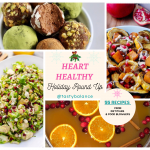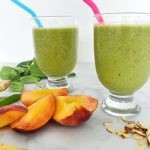
How do you feel about cabbage? I feel like this is one of those veggies that people either love or love to hate. It was a risk making this new dish, Roasted Red Cabbage and Shallots with Apple Cider Glaze, for a group of people with whom I had no idea whether they liked cabbage or not. Let me put it to you this way. That platter was clean and dry at the end of dinner, which unfortunately for me meant no leftovers to take home! But, I’m glad everyone gobbled up this amazingly healthy cruciferous vegetable.

All veggies have amazing health benefits, but red cabbage comes in towards the top!
That bright and deep purplish pink hue that red cabbage has comes from anthocyanins, a type of flavonoid polyphenol, which is a type of antioxidant. You find them in purple, blue and red fruits and veggies, including red cabbage, eggplant, berries, cranberries, plums, prunes, red skinned potatoes, red onions, and red radish.
And what do these anthocyanins do? Plenty! They fight free radicals and lessen oxidative stress in our cells (hello anti-aging!) and even positively affect the microflora in our gut. They may provide protection against a whole host of problems such as inflammation, cognitive decline, heart disease, cancer and more.
When you hear the words “cruciferous veggies”, cancer prevention may come to mind.
Cruciferous veggies contain glucosinolates. Wonder where the smell of cabbage comes from? It’s from this sulfur containing compound. While the smell may be a bit funky, just know that it’s coming from a good place! Through chewing and digestion, those compounds get broken down into a number of active compounds including indole-3-carbonol and sulphurophane. These are 2 substances often studied for anti-cancer effects.
So far, we’ve got red cabbage containing powerful antioxidants and cancer fighting substances, but that’s not it! We’re also looking at vitamin C, iron, vitamin K, vitamin A, lutein, zeaxanthin, folate, and of course, my favorite “F” word, fiber. Lutein and zeaxanthin are both substances that are crucial for eye health, so definitely eat up!
All of the nutrients above have many functions, but they also play a role in mood, cognition and overall brain health.
I want to highlight two vitamins as they pertain to brain health because they don’t get much publicity: vitamin C and vitamin K. Red cabbage contains a whopping 85% of the RDI (recommended daily intake) for vitamin K and 54% for vitamin C. Those are pretty big numbers!
Vitamin K is usually discussed in terms of it’s blood clotting functions, but it plays a number of roles in the brain. It play a protective role against inflammation and oxidative stress, in addition to assisting in the growth of brain lipids called sphingolipids, which are important in proper brain function. Vitamin K is a fat soluble vitamin, so the olive oil in this roasted cabbage recipe will help with the absorption of the vitamin.
We generally think of vitamin C beefing up the immune system, but it is also a powerful antioxidant the protects against inflammation. Our brains actually have a greater concentration of vitamin C than the rest of the body does. It plays a role in the growth and protection of neurons and plays multiples roles in the creation and release of neurotransmitters. Vitamin C is even needed in the conversion process of dopamine to serotonin, which of course is probably the most well known feel-good chemical in the body

You may be more familiar with traditional braised red cabbage, perhaps even with apples. I really like the roasted cabbage version better because I love the crispiness that you get with some of the ends and smaller pieces. The sweetness of the apple cider glaze also really stands out against the savory cabbage and shallots. If you want to get really fancy for your dinner, you can even top the dish with thin slices of oven dried green apples.
This is one of those dishes where when I made it for the first time, I stood in the kitchen eating from the sheet pan. The next day, I nibbled at the cold leftovers, not bothering to heat them up because they were still so tasty cold!
If you think you’re not a cabbage person, you have to try it roasted. The roasting process brings out the natural sugars in the veggies. Tender cabbage with crispy ends and sweet, caramelized shallots makes for some truly happy eating. While the apple cider glaze adds a really special touch to the dish, you don’t have to use it. The roasted shallots and cabbage are delicious on their own!


Roasted Red Cabbage and Shallots with Hard Apple Cider Glaze
Roasting is definitely my preferred method of cooking cabbage! When slicing the cabbage, don’t worry if pieces come apart. You’ll just end up with some tasty crispy smaller pieces. This side dish is delicious even if you don’t use the hard apple cider glaze, but it does add an extra dimension of flavor.
- Yield: 6 servings 1x
Ingredients
- 1 small head of red cabbage (about 2 pounds), cored and sliced in 1/2″ thick slices
- 9 ounces shallots, peeled and trimmed and roughly cut into 1” chunks
- 5–1/2 teaspoons avocado oil divided (or other oil such as olive oil)
- 1/2 teaspoon kosher salt
- 1 12-ounce bottle hard apple cider
- 1 teaspoon unsalted butter
Instructions
- Preheat oven to 425 degree F
- Place silicone baking sheets or parchment paper over 2 half size (18″x13″) sheet pans. Rub 1/2 teaspoon oil over each of the sheet pans.
- Divide the cabbage pieces between the 2 sheet pans.
- Drizzle 2 teaspoons of the oil over each sheet pan of cabbage.
- Toss 1/2 teaspoon oil with the shallots in a small mixing bowl and divide between the sheet pans, finding room in between the cabbage. Sprinkle the salt over the veggies on each sheet pan.
- Place pans in the oven. Check the cabbage and shallots after 20 minutes. If you see any extra crispy pieces, remove them from oven. Flip pieces of shallots over. Continue roasting for about 10 more minutes.
- While veggies roast, place cider in a saucepan over high heat. Allow to boil down until only about 2 Tablespoons are left. This should take somewhere around 17 minutes, depending on your stove and type of pan you are using. Once you get to 15 minutes, watch the pan closely.
- Turn stove top off and swirl the butter into the reduced cider.
- Remove veggies from oven and toss with cider glaze in a large bowl.
- Serve immediately.
Notes
The cabbage is also delicious cold or at room temperature!
Keywords: red cabbage, roasted, side dish, roasted vegetables, vegetarian, nut free, gluten free







This is beautiful! Talk about a great way to bring some color to the table! I love that you used hard cider in the dressing too. The mix of sweet cider and that nice roasted cabbage flavor blend so nicely together.
thank you so much Yaffi. it’s great without the cider glaze, but definitely adds a really nice flavor dimension
Now I HAVE to try roasting cabbage!
you need to!! But then again, I never met a roasted vegetable I didn’t like. lol
This looks absolutely delicious! I just love all of the colors!
thank you so much Katie!
Mmm roasted veggies are my fave! This looks so delicious
Thanks Abbey! If people tell me they don’t like veggies, I tell them to try them roasted! Such a game changer 🙂
Love the idea of getting a little tipsy on cabbage! This looks super yummy and creative.
Thanks so much Mary! Cabbage is such a versatile veggie!
I really want to make this soon!
🙂 Hope you do!